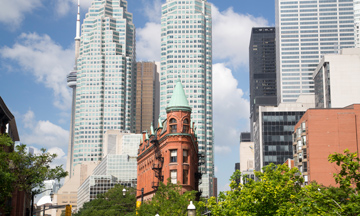A preview of a new exhibition by Chinese artist Ai Weiwei at the Gardiner Museum of Ceramic Arts, in Toronto, on Feb 26, 2019. Moe Doiron
At the Gardiner Museum of Ceramic Art in Toronto, a perilous pillar of six large blue-and-white vases towers over an exhibition by Chinese art star and activist Ai Weiwei. The decorative vases look like traditional Chinese porcelain but a closer examination reveals images of soldiers with guns and fleeing refugees wrapped around the sides. Audiences who have followed Ai’s recent investigation of migration issues, including the meditative documentary Human Flow, may see the vases simply as an extension of that concern into the multi-disciplinary artist’s studio work. Yet in this exhibit, the vases are placed in the context of the artist’s relationship with his materials: The Gardiner Museum’s bright idea of a show devoted to his ceramics offers a smart synopsis of the artist’s working methods.
Ai first established himself as a conceptual artist. So, at the Gardiner, it is probably best to begin with a trio of photographs from 1995: Dropping a Han Dynasty Urn records the provocative moment when Ai did precisely that. The action was clearly an artistic critique of how we ascribe value to art and to history. Meanwhile Ai’s impassive face, his simple, baggy clothing (including black Chinese slippers) and his own replies to those outraged by the smashing of a 2,000 year-old artifact also link it directly to the Cultural Revolution’s purposeful destruction of Chinese art.
His investigation of how China values its past, and of the impact of the rapid economic liberalization that began in the 1990s, continued with works such as Coca-Cola Vase, a piece from 2007 in which he painted the ubiquitous soft-drink logo on to a Neolithic vase. This show also includes a work from 2015 in which he painted a quartet of larger Han urns with the automotive paints used for luxury cars.
A trio of photographs from 1995: Dropping a Han Dynasty Urn records the provocative moment when Ai did precisely that. Moe Doiron
How much desecration is involved here? As China’s building boom unearthed quantities of old pottery from the ground, these ceramics flooded into flea markets where Ai could easily buy them. Gardiner chief curator Sequoia Miller points out the Han urn of 1995 was a lesser example of ancient pottery that was mass produced, and that even the 5,000 to 7,000-year-old Neolithic vase is not a particularly valuable specimen of its kind.
Ironically, pieces such as these are now worth far more than the ancient originals Ai repurposes. The ubiquity and the devaluation of these historic materials is, of course, the artist’s point. In Dust to Dust of 2009, he fills a wooden cabinet with jars containing the remnants of ancient pottery shards, which have been ground up for the purpose. That pottery may be reduced to dust, but Ai also made a habit of rescuing old wooden doors from demolition sites; here, in a handful of carved stone pieces included among the ceramics, the artist produces copies of the doors in marble, that heroic (and Western) sculptural medium.
That relationship with Jingdezhen has grown and, as this show demonstrates, Ai thinks deeply about these materials, becoming something of an expert on both traditional ceramics and carpentry. This collection boasts a one-tonne pile of his famous sunflower seeds: Each one is a tiny piece of hand-painted porcelain in a work of a million parts that took many hands to create – and which comments on craft, authorship and the nature of the collective. Meanwhile, the centerpiece of the show, which seems to be included more as an anchoring presence than for its link to the ceramics, is a massive tree cobbled together from numerous dead branches and held together with bolts and traditional Chinese joinery techniques.
A massive tree cobbled together from numerous dead branches is the centerpiece of the show. Moe Doiron
It’s the largest object in the room at the Gardiner; among the smallest are two pairs of handcuffs, one made of rosewood, the traditional material for Chinese furniture, and the other of jade. When Chinese authorities imprisoned Ai for three months in 2011, he was handcuffed for a daily interrogation.
So this exhibit is not merely about its materials: Ai’s sharp questioning of Chinese attitudes to history and modernity inevitably leads him to issues of human rights. One of the least subtle pieces here is a marble version of a security camera trained permanently on his house after he was released from prison. Themes of authority, freedom and surveillance became personalized during the period of his virtual house arrest: a 2014 flowered dish refers both to the “flowers” lost in the 2008 Sichuan earthquake, which killed thousands of school children, and to the real flowers he placed outside his own door as a retort to his ever-present guards.
The artist relocated to Berlin in 2015, and his concerns about human rights have become increasingly global as he widens his criticisms to include the West. In February, he denounced the producers of the anthology film Berlin, I Love You because he felt their decision to cut his contribution was due to Chinese pressure. In January, in anticipation of his Toronto show, he issued a statement through the Gardiner responding to the diplomatic row between China and Canada over the arrest of Huawei chief financial officer Meng Wanzhou in Vancouver. He did not call out Canada specifically but decried Western hypocrisy, suggesting the West was complicit in Chinese authoritarianism because it financially profited from China’s economic rise.
This collection boasts a one-tonne pile of his famous sunflower seeds. Moe Doiron
When it comes to his art, he brings a rich Chinese vocabulary to an increasingly global project. The show includes an intriguing example of his latest medium – Lego. A series of large Lego panels feature digitized images of the animals of the Chinese zodiac and a two-dimensional version of large bronzes erected in New York’s Central Park in 2011. The animals look more western in style than eastern: they are inspired by figures from the Old Summer Palace in Beijing that were dictated to Chinese sculptors by Jesuit missionaries, and then looted by European forces during the 19th-century Opium Wars. So who is copying whom? And, as Middle Eastern migrants at sea in the Mediterranean wash across the surface of a Chinese vase, who is rescuing whom? By concentrating on the artist’s ceramics, the Gardiner brings Ai’s provocative questions into sharp relief.
Ai Weiwei: Unbroken continues at the Gardiner Museum in Toronto until June 9.
Published Kate Taylor, Feb 28th, 2019 (Globe and Mail)



/arc-anglerfish-tgam-prod-tgam.s3.amazonaws.com/public/7EEPL2VL3RDPHEP4FUWGISFVVU.JPG)
/arc-anglerfish-tgam-prod-tgam.s3.amazonaws.com/public/SGPOZQPN4BHGNJD7J7R2COCSVA.JPG)
/arc-anglerfish-tgam-prod-tgam.s3.amazonaws.com/public/VC2IOQNQ4VE7JL6MF7277RZHR4.JPG)
/arc-anglerfish-tgam-prod-tgam.s3.amazonaws.com/public/W5Z2VL4O4VBDXC3XZJ43PGUG6E.JPG)